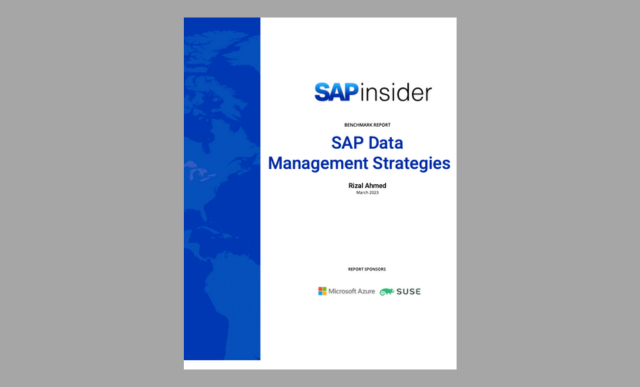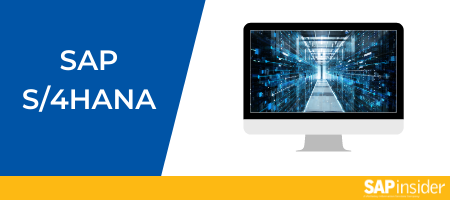How SAP Data Management Today Impacts Your Business Tomorrow
Key Takeaways
⇨ There is a low level of satisfaction with data management strategy.
⇨ Less than a quarter of companies are moving purely to the cloud.
⇨ Of all the cloud concerns, privacy is at the top.
Introduction
Over the past decade, data has played an increasingly larger role in business. Enterprises have begun investing in their data, adopting data management strategies and tools that unlock the value hidden inside their data estates. This is especially true for those with legacy SAP deployments—platforms where data stored locally, in the cloud, or on a combination of both can create disparate data silos.
As an IT leader or professional, it is very likely SAP data management is a priority for your department—mandated or otherwise. Proper data management promises business acceleration, more accurate forecasting with analytics, and greater innovation. To tap into these transformational benefits, organizations are turning to company-wide strategies. Regardless of their affinity for on-prem, cloud, or hybrid SAP deployments, leading enterprises are taking action today to revolutionize their business tomorrow.
The status quo of SAP data management strategy
At Pythian, our teams have observed that SAP customers plan to tap into the in-memory benefits of SAP HANA—as a precursor to S/4 HANA—and fully lean into hyperscale cloud. Others are iterating on their on-prem deployments or embracing hybrid models. In any case, a data management strategy must factor in legacy data (especially in brownfield or hybrid approaches). Organizations must develop frameworks to support business performance while reducing organizational complexity.
However, many know that executing against any enterprise data strategy isn’t enough. Today, organizations are often disappointed by their data management efforts and are looking for ways to improve. In a SAPinsider survey of enterprise businesses and professionals, forty-five percent of respondents reported they had an enterprise-wide strategy for their SAP and non-SAP data. In the same poll, forty-five percent also noted that despite having a plan, they were unsatisfied with how these strategies tracked their business requirements.
The pressure has never been higher for IT teams to provide real-time data to stakeholders, migrate datasets and applications to the cloud, and unlock the power of analytics. Yet, for many, the way forward seems opaque, and questions abound:
How do you develop a data management plan that considers legacy data? How do you prioritize cloud data security, governance, integrity, and compliance? How does our organization even prepare for a migration to SAP HANA? How are successful organizations navigating these data management challenges?
The DART model: insights into the SAP enterprise management landscape
To help answer these questions and gain more insight into SAP customer challenges, strategies, and aspirations, SAPinsider surveyed 138 global IT professionals between March and April 2022. Using its proprietary DART model (Drivers, Actions, Requirements, and Technologies), SAPinsider unpacked the connections between company Drivers, Actions, Requirements, and Technologies that highlight key SAP customer trends.
SAPinsider leverages this same model to educate its users and validate success in the marketplace. In our experience, this research framework draws upon numerous essential threads that educate and empower SAP customers.
As a result, this fact-based model provides clear takeaways on company pressures, how they act upon those pressures, what resources are required for a successful strategy, and what technologies they are implementing.
In more detail, DART comprises:
- Drivers: The internal and external pressures that drive business directions and decisions.
- Actions: The strategies taken by organizations to address and solve business Drivers.
- Requirements: The process, people, and capabilities required for the recommended Actions to be successful.
- Technologies: The various technologies required to fulfill the aforementioned Requirements.
Over the next four articles, I’ll share practical insights on leveraging these crowd-sourced insights while sharing some supporting examples from my professional experience. It is my hope that driving SAP migration and data management strategies today can help you reap the rewards of innovation, IT modernization, and business acceleration tomorrow.
Drivers: uncovering the main drivers of data management strategy
The first component of the DART model, Drivers, are the macro-level events and scenarios that impact an organization. Some examples of business Drivers could be mounting process inefficiency across an organization, rapid increases in data appetites from stakeholders, or significant budget cuts due to market pressures—anything that applies pressure and invokes a need for change within your business. As an IT leader or professional, you’re likely well-acquainted with these pressures: they’re responsible for much of your reactionary and anticipatory SAP data management efforts.
Today, an assortment of consumer and competitive pressures are driving a specific behavior across the enterprise: pushing on-prem databases to the cloud. Upstart businesses born in the cloud are nimbler and extract more value from their growing data estates, posing more significant challenges to enterprises on legacy SAP systems.
When planning and investing in IT modernization and enterprise data strategies, some clear trends across SAP customers drive their business decisions and strategy. I’ve shared my commentary below to give you some additional insight into these shared challenges and priorities.
Increasing demand to provide real-time data fast to internal users, partners, and customers (46%)
In our experience, this trend is led by several factors.
The first—competition in the marketplace—is a leading factor. Numerous market-leading enterprises have already laid the infrastructure to efficiently collect, store, analyze, and take action upon their ERP, customer, marketing, and other data types. This efficiency has dramatically contributed to their business growth, innovation, and differentiation. Competitors are playing catch-up in hopes of capitalizing on these business opportunities.
Secondly, businesses are finding the actual value of data science. They have begun understanding the relevance of their data, how to connect data across silos, how to analyze it, and how to leverage it to deliver key business objectives. This rapid maturity of data science in the enterprise is evident by the number of courses, organizations, credentials, and data science career opportunities available today that weren’t available just ten years ago.
High demand for company-wide intelligence and analytics for trend and transactional data (32%)
Linked closely to the adoption of hyperscale cloud is the rising demand for enterprise-wide intelligence and analytics. Approximately 75% of SAP survey respondents expect to transition their analytics and business intelligence applications to the cloud, unlocking more business automation capabilities while increasing agility.
The increased demand for trend and transactional data is closely tied to the appetite mentioned above for real-time data and analytics, helping organizations stay competitive in a modernizing marketplace.
IT budget pressures to keep capital and operating costs under control (31%)
With the global financial markets in flux, it is safe to expect this trend to rise. IT leaders will likely be tapped to do the same—or more—with less. In 2022, many IT departments are expecting budget cuts. Technology teams have also experienced little to no reprieve from the personnel challenges exacerbated by the COVID-19 pandemic.
Skyrocketing volumes of unstructured/semi-structured data to analyze and drive business processes (21%)
The fewest survey respondents flagged increasing volumes of data—which, in the case of legacy SAP systems, can create numerous silos—as a major business Driver. Regardless, this number presents nearly a quarter of enterprises who feel connecting data volumes to business processes is a top Driver, thus requiring a complementary strategy (also called a business Action within the DART model).
As enterprises collect more data across growing data estates, it is not uncommon for data quality, integrity, security, and governance to suffer—especially in heavy data compartmentalization. We believe that as more businesses seek access to real-time data for better decision-making, this data’s storage, health, governance, and security will come into the spotlight.
Analyses driving business decisions are only as valuable as the quality of their data. Considering that thirty to forty percent of business reports have zero value due to decreasing data quality, skyrocketing data volumes might be more of a challenge than anticipated.
Real-world business Driver examples: Morse Hydraulics
A real-world example may prove helpful to further crystalize the idea of business Drivers—and why identifying them along your SAP data management journey is important. For example, let’s look at Morse Hydraulics—a Pythian client. Morse Hydraulics has been in business for more than two decades. As a hydraulics products manufacturer, its offerings include field engineering, on-site assembly, crimping, cutting services, and more.
This diverse portfolio required a sophisticated resource planning system capable of driving innovation and meeting business demands. Morse Hydraulics had long relied on its legacy on-premise SAP ECC system for accounting, resource planning, and business analytics. However, over time, the organization began to feel ‘stuck’:
- Stakeholders felt limited by their existing system, unable to move with the agility that promised innovation
- The reporting processes were complex and inefficient, making it difficult to deliver real-time insights to business users
Looking closely, it is evident that these internal business pressures correlate with several of the Drivers commonly reported by SAPinsider survey respondents. Teams are frequently seeking real-time data for better decision-making (46%), want greater access to business-wide trends and analytics (32%), and strive to better manage larger data volumes as they grow (21%).
Pythian took these Drivers in conjunction with the client’s unique requirements when creating an SAP S/4 HANA migration and data management strategy. These Drivers, which dictate the needs of the organization, helped outline what Actions (strategies) might best be leveraged, what Requirements (resources to enact the strategy) would be mustered, and what Technologies (tools and applications) would be used and integrated to best serve them.
Considering Morse Hydraulics’s unique needs, Pythian facilitated a deep technical assessment, ran compatibility checks, conducted a Brownfield S/4 HANA migration for reduced downtime, and delivered several self-serve and proprietary SAP tools to enable digital transformation—directly addressing their most pressing Drivers.
***
Now that we have fleshed out the key drivers for data management strategies found by SAPinsider, over the next few articles, we will discuss how and what you need to leverage these insights to create a valuable data strategy for your business.
Throughout this series, I will dig deeper into several high-level, critical takeaways from the SAPinsider report findings,
- There is a low level of satisfaction with data management strategy: as previously mentioned, forty-five percent of survey respondents had a company-wide data management strategy, yet forty-five percent were unsatisfied with how these strategies impacted their business goals. Nearly half of the organizations have a strategy of some kind, but half cannot properly measure their success.
- Less than a quarter of companies are moving purely to the cloud: Thirty percent of surveyed professionals said their organizations were moving to the cloud or data warehouses, while fifty percent would be adopting a hybrid model. These organizations often adopt many tools for data orchestration, security, governance, and archiving.
- Of all the cloud concerns, privacy is at the top: Directly related to the prior finding, enterprises are concerned about the challenges the cloud presents. Fifty-three percent of respondents said data privacy was a cloud migration concern, followed by the management of legacy data and applications at forty-nine percent.
Implement education and training for all IT and business stakeholders that touch, manage, or use data. The number of business stakeholders who will generate, access, handle, and mold data are rising. Low code/no code self-service options are increasing. A vigorous training program on the dos and don’ts of data will provide value while minimizing issues.
If you enjoyed reading this article, please leave a comment below. In Part Two, I will be touching upon business Actions—the actual strategies—enabling enterprise transformation.
If you want to read the entire research report published by SAPinsider, you can download it now.
Modernizing your SAP data with cloud
To achieve better predictions and drive innovation, businesses must rationalize, centralize, and govern their data. Enterprises with SAP housing third-party data, HR, finance, and marketing data are looking to unify their growing silos of structured and unstructured data. To galvanize their SAP data, they’re looking to migrate their disparate data sources to modern, hyperscale cloud platforms.
Many organizations are using Google Cloud, Amazon Web Services (AWS), and Microsoft’s Azure hyperscale cloud to harness the full potential of their data estate. SAP on HANA provides a flexible and scalable data platform with fewer on-premises configurations and smaller footprints.
Enterprise data is coming to an inflection point. Migrating and upgrading your legacy SAP ERP (ECC) or Business Warehouse (BW) environments can help you stay ahead.








